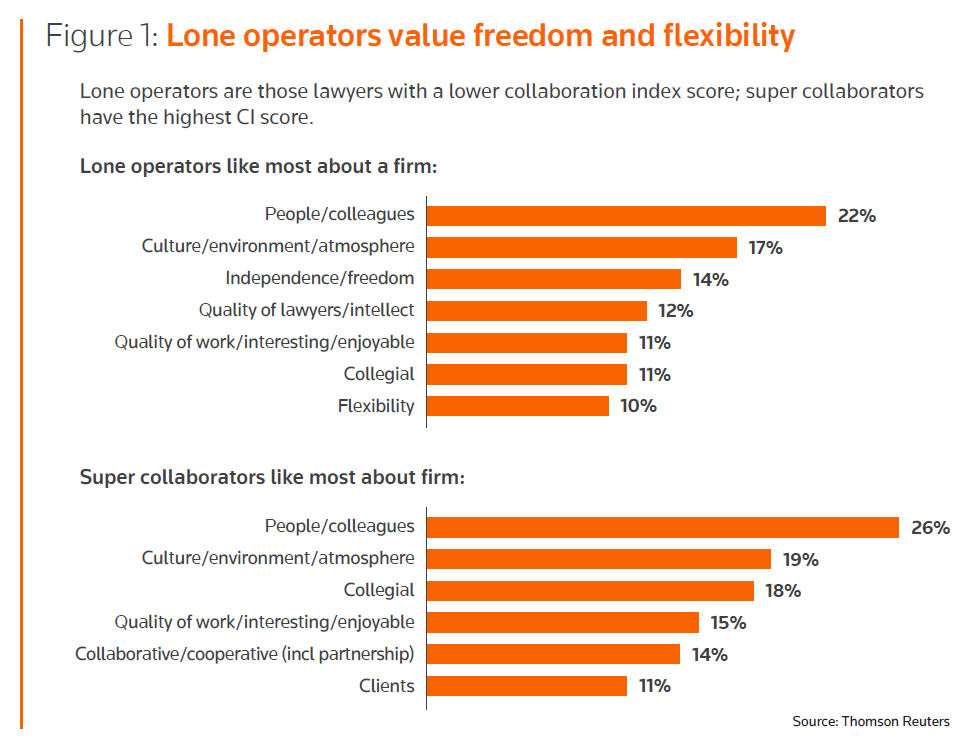In the fifth and final installment in our series of "Stellar Performance Research" reports, we look at how encouraging collaboration among lawyers can have positive ripple effects within law firms
Collaboration on legal matters has the potential to be a huge engine of growth for law firms, yet too often it is misunderstood or misused. Indeed, properly encouraged collaboration can make a law firm more sticky in the mind of clients, potentially earning the firm a larger share of clients’ legal spend and increasing the chances that it will become the client’s go-to source across a range of specializations, practice areas, and legal matters.
In a new series of Stellar Performance Research reports, we have looked at the experiences that Thomson Reuters Stand-out Lawyers — those nominated by their clients as being exemplary attorneys — have had with such critical topics as lateral hiring, client feedback, recruitment and retention, lawyer engagement, collaboration, and more. In our earlier reports, we looked at formal client feedback programs, retaining top associates, ensuring successful lateral hires, and lawyer engagement, and now we look at how top lawyers view collaboration, including their individual preferences and what they see as the benefits of and barriers to collaboration.
From this data, gathered from a survey of 2,400 Thomson Reuters Stand-out Lawyers around the world, we present a picture of what top lawyers think about collaboration and how firms can best encourage it, as well as the effect that pandemic-era working styles have had on collaboration.
As outlined in this report, our research finds that the benefits of collaboration between partners are impressive: Higher collaboration is linked to increased billable hours, more work billed, and higher origination levels. We also found that a law firm culture that promotes collaboration can see non-financial benefits too, such as a stronger sense of engagement among their lawyers, because collaboration helps create and strengthen ties within the firm.
Levels of collaboration in today’s legal world
To better understand and analyze the state of collaboration within law firms, we developed a collaboration index that we used to measure the frequency at which lawyers work with others. Specifically, the index incorporates:
-
-
-
- the proportion of matters on which a lawyer worked that were not self-originated;
- the proportion of self-originated matters that involved other partners from within the same practice; and
- the proportion of self-originated matters that involved other partners from other practices.
-
-
According to these measures, collaboration on matters is slightly higher now than it was before the pandemic, and remote work doesn’t seem to have affected collaboration on legal matters. However, anecdotally, partners say that buy-in and collaboration on firm initiatives is lower. One reason for this dichotomy may be that given the increased connectivity made necessary by pandemic-era work requirements, relationships between offices may be better, but those individual relationships within an office may have suffered.
We also noted a difference in the thinking of those lawyers we categorized as super collaborators compared to those we identified as lone operators.

Not surprisingly, a higher level of collaboration is linked to much higher matter originations and value of work billed, as collaboration apparently enables partners to win bigger matters, which are likely to have a higher value than work that can be won by a single partner.
How firms can encourage collaboration
Our survey identified many opportunities for law firms to improve levels of collaboration among their partners and other top lawyers. Cross-practice groups, such as industry sector teams, are strongly associated with higher levels of collaboration, as is providing the right technology to support collaboration and employing project managers to help smooth the way.
We also found that a lack of direct financial incentives is also holding back some partners, especially non-equity partners, from fully collaborating with others. This suggests that firms might want to change their compensation packages to ensure that collaboration is explicitly included. Further, it’s important to actively educate and communicate with lawyer teams the valuable impact that collaboration has on key performance metrics, especially originations and hours billed.
As our research results suggest and the report makes clear: Those law firms that are actively working to ensure that their lawyers are encouraged to collaborate more often and are providing their lawyers with the appropriate support to ensure those collaborations are successful, will be the ones seeing more success and ultimately, more client dollars.
You can access the full report, “Stellar Performance 2023: Collaboration — The Key to Success in Originations, Billing, and Compensation” by filling out the form below:







